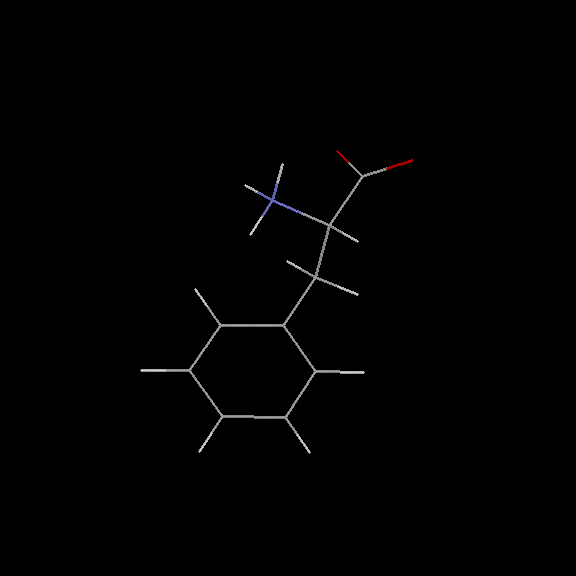L-phenylalanine
Phenylalanine, classified as an essential amino acid for humans, plays a pivotal role as a building block of proteins. Encoded by the mRNA codons UUU and UUC, it possesses a distinctive phenyl group, rendering it an aromatic nonpolar residue with unique UV absorption characteristics around a 260 nm wavelength.
Under the action of phenylalanine hydroxylase, it can be transformed into another amino acid, tyrosine. This amino acid serves as a precursor to several important molecules, including dopamine, noradrenaline, adrenaline, and melanin. Additionally, it is a key component of aspartame, an artificial sweetener widely used in the food industry.
Phenylalanine is also associated with an inherited metabolic disorder known as phenylketonuria (PKU), which is caused by a deficiency in phenylalanine hydroxylase, an enzyme that converts phenylalanine into tyrosine. Individuals with PKU must adhere to a strict diet with a significant reduction in phenylalanine intake to avoid the accumulation of toxic phenylalanine in the body.
As a precursor to various neurotransmitters, phenylalanine plays a crucial role in regulating mood, sleep, and stress response. Studies suggest that phenylalanine supplementation may have beneficial effects on cognition, attention, and memory, although further research is needed to better understand its potential impact on mental and neurological health.
Phenylalanine exists in two forms: L-phenylalanine and D-phenylalanine, with L-phenylalanine being the natural form found in proteins and dietary sources. D-phenylalanine, on the other hand, is not typically found in proteins and is often used in research and certain medical applications.
In addition to its role in protein synthesis, phenylalanine is also associated with the production of various compounds, such as tyrosine, dopamine, norepinephrine, epinephrine, and melanin. These compounds are essential for the proper functioning of the nervous system, including the regulation of mood, emotions, and cognitive processes.
Phenylalanine is naturally present in various protein-rich foods, including meat, fish, eggs, dairy products, nuts, and seeds. However, individuals with PKU must strictly monitor their intake of phenylalanine from dietary sources to prevent the adverse effects associated with its accumulation.
Phenylalanine is also known for its role in the synthesis of other important molecules and neurotransmitters. It serves as a precursor for the production of tyrosine, which is a precursor for neurotransmitters such as dopamine, norepinephrine, and epinephrine. These neurotransmitters play crucial roles in the regulation of mood, behavior, and cognitive function. Additionally, phenylalanine is involved in the production of melanin, which is responsible for determining skin and hair pigmentation.
The regulation of phenylalanine is particularly important in individuals with phenylketonuria (PKU), a genetic disorder that impairs the body's ability to process phenylalanine. In PKU, the accumulation of phenylalanine and its byproducts can lead to intellectual disabilities, developmental delays, and other neurological issues. Managing phenylalanine intake through a carefully controlled diet is crucial for individuals with PKU to prevent these complications.
Furthermore, phenylalanine has gained attention in the field of nutrition and health supplements. It is sometimes used in the form of dietary supplements to support cognitive function, mood regulation, and overall well-being. However, its use as a supplement should be approached with caution, especially for individuals with certain health conditions or those taking specific medications, as it can potentially interact with other compounds and lead to adverse effects.
Accession Number : KLM0000302 This work is released into the public domain; please see our release statement.
Doug Markham has contributed a molecular mechanics computation of the structure! See below for the details.

Synonyms :
- L-PHENYLALANINE
- Phe
- F
Config Rule :
config('L-phenylalanine',[
substituent(aminoacid_L_backbone),
substituent(benzyl),
linkage(from(aminoacid_L_backbone,car(1)),
to(benzyl,car(1)),
down,single)]).
%%%% Substituent Config Rules for compound 'L-phenylalanine' %%%%
config(aminoacid_L_backbone,[
left(amino),
right(hyd),
top(carboxyl),
center(car(1))]).
config(benzyl,[
substituent(phenyl),
substituent(methandiyl),
linkage(from(methandiyl,car(1)),
to(phenyl,car(1)),
nil,single)]).
%%%% Substituent Config Rules for compound benzyl %%%%
config(phenyl,[
ring([
car(1)&,
car(2,hyd)&,
car(3,hyd)&,
car(4,hyd)&,
car(5,hyd)&,
car(6,hyd)&])]).
Smiles String :
[C@2H]([NH3+])([C](=[O])[O-])[C@2H2]-[c]1([cH][cH][cH][cH][cH]1) 'L-phenylalanine'
Terminal :
% 'L-phenylalanine'
c(1,12,(0,chiral))-[n(1,left)~,h(1,right)~,c(2,up)~,c(3,down)~],
c(2,12,(0,nonchiral))-[o(1,nil)?,o(2,nil)?,c(1,down)~],
c(3,12,(0,nonchiral))-[c(4,left)~,h(5,right)~,c(1,up)~,h(6,down)~],
c(4,12,(0,nonchiral))-[c(3,right)~,c(9,flat)&,c(5,flat)&],
c(5,12,(0,nonchiral))-[h(7,nil)~,c(4,flat)&,c(6,flat)&],
c(6,12,(0,nonchiral))-[h(8,nil)~,c(5,flat)&,c(7,flat)&],
c(7,12,(0,nonchiral))-[h(9,nil)~,c(6,flat)&,c(8,flat)&],
c(8,12,(0,nonchiral))-[h(10,nil)~,c(7,flat)&,c(9,flat)&],
c(9,12,(0,nonchiral))-[h(11,nil)~,c(8,flat)&,c(4,flat)&],
h(1,1,(0,nonchiral))-[c(1,left)~],
h(2,1,(0,nonchiral))-[n(1,right)~],
h(3,1,(0,nonchiral))-[n(1,down)~],
h(4,1,(0,nonchiral))-[n(1,up)~],
h(5,1,(0,nonchiral))-[c(3,left)~],
h(6,1,(0,nonchiral))-[c(3,up)~],
h(7,1,(0,nonchiral))-[c(5,nil)~],
h(8,1,(0,nonchiral))-[c(6,nil)~],
h(9,1,(0,nonchiral))-[c(7,nil)~],
h(10,1,(0,nonchiral))-[c(8,nil)~],
h(11,1,(0,nonchiral))-[c(9,nil)~],
n(1,14,(1,nonchiral))-[h(2,left)~,c(1,right)~,h(3,up)~,h(4,down)~],
o(1,16,(-5.0E-01,nonchiral))-[c(2,nil)?],
o(2,16,(-5.0E-01,nonchiral))-[c(2,nil)?]
The Terminals for all the Config Rules are in Prolog Definite Clause Grammar (DCG) form.They can be checked in the Manual here.
The compound's PDB file can be seen here.
Doug Markham of the Institute for Cancer Research, Fox Chase Cancer Center,Philadelphia, PA, has contributed the following structure for L-phenylalanine. He computed this structure in sdf format using MacroModel, a molecular mechanics program. We have used Babel to convert the .sdf format to PDB format. You'll find it interesting to compare these structures to those computed using CONCORD.
Many thanks Doug!
